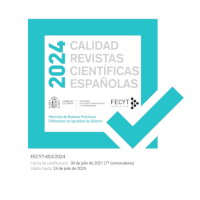Irish Mother and Baby Homes’ fostered children reconstructing their past in Phyllis Whitsell’s "My Secret Mother" (2015) and "A Song for Bridget" (2018)
DOI:
https://doi.org/10.18172/cif.4700Keywords:
Mother and Baby Homes, vulnerability, trauma, healing, identityAbstract
Considered “outcasts”, unmarried mothers were secluded in Mother and Baby Homes and Magdalene Laundries during the twentieth century, where they were deprived of their children (Luddy 2011: 109-126). Phyllis Whitsell’s My Secret Mother (2015) and A Song for Bridget (2018) explore the Mother and Baby Homes regime of power, which rendered thousands of women in Ireland in a vulnerable position, and the adoption business the nuns had, which deprived thousands of women of their right to be mothers (Garrett 2010: 330-343). In this article our intention is to explore the trauma caused in both unmarried mothers and illegitimate children by the Irish Catholic system of correction and what sources of healing are offered to them in restoring their identities in the aftermath of their release. To that aim, we will employ Trauma Studies.
Downloads
References
BYRNE-EARNER, L. (2007). Mother and Child. Maternity and Child Welfare in Dublin 1922-60. Manchester: Manchester University Press.
FASSIN, D. (2007). “Humanitarianism as a Politics of Life”. Public Culture 19 (3): 499-520. <http://www.sss.ias.edu/files/pdfs/Fassin/Humanitarianism-as-politics-life.pdf>. (Accessed 8 Mar. 2020). DOI: https://doi.org/10.1215/08992363-2007-007
FASSIN, D. (2012). Humanitarian Reason. A Moral History of the Present. Translated by Rachel Gomme, Berkeley and Los Angeles: University of California Press. DOI: https://doi.org/10.1525/9780520950481
FERRITER, D. (2005). The Transformation of Ireland 1900-2000. Great Britain: Profile Books.
FINNEGAN, F. 2004 (2001). Do Penance or Perish. Magdalen Asylums in Ireland. New York: Oxford University Press. DOI: https://doi.org/10.1093/acprof:oso/9780195174601.001.0001
FLANAGAN, P. (2019). “Pat Flanagan Column: Selling 1,000 Dead Babies Shows how much Catholic Church Hated Children.” Irish Mirror 19 April 2019, <https://www.irishmirror.ie/news/irish-news/pat-flanagan-column-selling-1000-14432475?fbclid=IwAR0ohJFNLtT4hFCc0ZMpvObot51t1cQYR91KGFqBEDN5WEc5f4hSj_MdyM>. (Accessed 21 Jan. 2020).
GARRETT, P. M. (2010). “The Abnormal Flight: The Migration and Repatriation of Irish Unmarried Mothers”. Social History 25 (3): 330-343. DOI: https://doi.org/10.1080/03071020050143356
GARRETT, P. M. (2016). “‘Unmarried Mothers’ in the Republic of Ireland”. Journal of Social Work 16 (6): 708-725. <https://journals.sagepub.com/doi/abs/10.1177/1468017316628447?journalCode=jswa>. (Accessed 20 March 2020). DOI: https://doi.org/10.1177/1468017316628447
HERMAN, J. L. (1998). Trauma and Recovery: from Domestic Abuse to Political Terror. London: Pandora.
HURLBERT, C. M. 2013 (2012). National Healing: Race, State, and the Teaching of Composition. Colorado: Utah State University Press. DOI: https://doi.org/10.2307/j.ctt4cgs0k
KAPLAN, A. E. (2005). Trauma Culture. The Politics of Terror and Loss in Media and Literature. New Brunswick, New Jersey, and London: Rutgers University Press.
LAUB, D. (1992). “Bearing Witness, or the Vicissitudes of Listening” in Testimony: Crises of Witnessing in Literature, Psychoanalysis, and History. (Coords. Shoshana Felman and Dori Laub). Great Britain: Routledge: 57-74.
LAUB, D. (1995). “Truth and Testimony: the Process and the Struggle” in Trauma: Explorations in Memory. (Coord. Cathy Caruth). Baltimore (USA): The Johns Hopkins University Press: 61-75.
LUDDY, M. (2007a). Prostitution and Irish Society. 1800-1940. Cambridge: Cambridge University Press.
LUDDY, M. (2007b). “Sex and the Single Girl in 1920s and 1930s Ireland”. The Irish Review 35: 79-91. <https://www.jstor.org/stable/29736321?seq=1#page_scan_tab_contents>. (Accessed 20 Apr. 2020).
LUDDY, M. (2011). “Unmarried Mothers in Ireland, 1880-1973”. Women’s History Review 20 (1): 109-126. DOI: https://doi.org/10.1080/09612025.2011.536393
MARION, Y. I. (1998). “Breasted Experience. The Look and the Felling” in The Politics of Women’s Bodies. (Coord. Rose Weitz). Oxford: Oxford University Press: 125-136.
MCCORMICK, L. (2009). Regulating Sexuality: Women in Twentieth-century Northern Ireland. Manchester: Manchester University Press. DOI: https://doi.org/10.7228/manchester/9780719076640.001.0001
MILOTTE, M. (1997). Banished Babies: The Secret History of Ireland’s Baby Export Business. Dublin: New Island Books.
OFFICE OF THE ATTORNEY GENERAL. (1972). “Social Welfare Act, 1973”. Government of Ireland. . (Accessed 17 Apr. 2020).
O’SULLIVAN, E. -and O’DONNELL, I. (2012). Coercive Confinement in Ireland. Patients, Prisoners and Penitents. Manchester: Manchester University Press.
PÉREZ VIDES, A. (2016). “Disciplined Bodies. The Magdalen Spectacle in Contemporary Irish Cultural Texts.” Revista Canaria de Estudios Ingleses 73: 15-30. <https://dialnet.unirioja.es/servlet/articulo?codigo=5722254>. (Accessed 25 March 2020).
PERKIN, J. 1989 (1988). Women and Marriage in Nineteenth-century England. Chicago: Lyceum Books.
SABSAY, L. (2016). “Permeable Bodies: Vulnerability, Affective Powers, Hegemony” in Vulnerability in Resistance. (Coords. Judith Butler, et al.). Durham (USA): Duke University Press: 278-302. DOI: https://doi.org/10.2307/j.ctv11vc78r.18
SIMPSON, A. V., et al. (2014). “Doing compassion or doing discipline? Power relations and the Magdalene Laundries”. Journal of Political Power 7 (2): 253-274, . (Accessed 6 Apr. 2020). DOI: https://doi.org/10.1080/2158379X.2014.927684
SMITH, J. M. (2007). Ireland’s Magdalen Laundries and the Nation’s Architecture of Containment. Indiana: U of Notre Dame P. DOI: https://doi.org/10.2307/j.ctvpj76pf
TITLEY, B. (2006). “Heil Mary: Magdalen Asylums and Moral Regulation in Ireland”. History of Education Review 35 (2): 1-15. <https://www.thefreelibrary.com/Heil+Mary%3A+Magdalen+asylums+and+moral+regulation+in+Ireland.-a0164638617>. (Accessed 11 March 2020). DOI: https://doi.org/10.1108/08198691200600007
WHITSELL, P. (2015). My Secret Mother. Canada: Harper Collins Publishers.
WHITSELL, P. (2018). A Song for Bridget. London: Mirror Books.
Downloads
Published
How to Cite
Issue
Section
License
The authors retain copyright of articles and authorize CIF the first publication. They are free to share and redistribute the article without obtaining permission from the publisher as long as they give appropriate credit to the editor and the journal.
Self-archiving is allowed too. In fact, it is recommendable to deposit a PDF version of the paper in academic and/or institutional repositories.
It is recommended to include the DOI number.
This journal is licensed under a Creative Commons Attribution 4.0 International License














